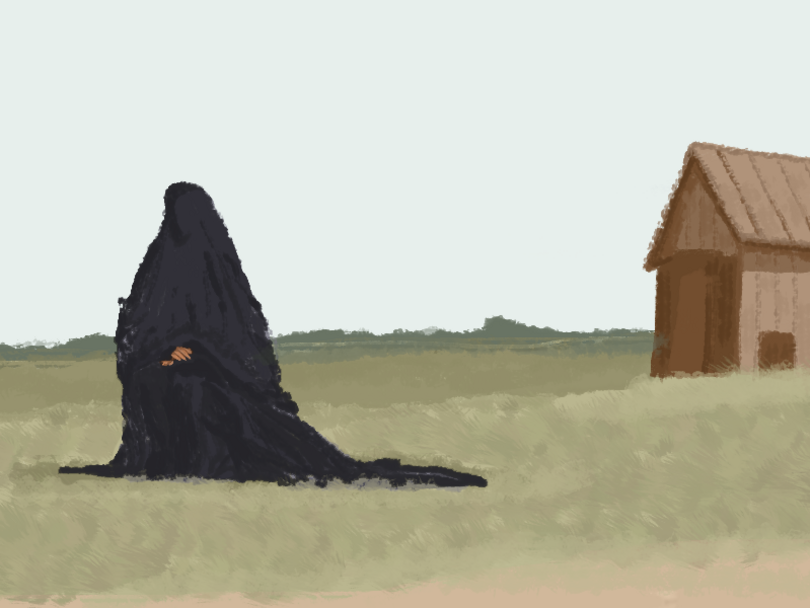‘The Woman in The Yard’ uses cinematography, direction to overcome cliches

“The Woman in the Yard” is a horror film that symbolically depicts death through the main terrorizer, a woman dressed in black. Although typically a cliche comparison, director Jaume Collet-Serra made the film interesting through abnormal camera work and well developed family dynamics. Abby Aggarwala | Contributing Illustrator
Get the latest Syracuse news delivered right to your inbox.
Subscribe to our newsletter here.
Content warning: This article contains mentions of suicide.
Following the 2022 anti-hero trainwreck “Black Adam,” director Jaume Collet-Serra could’ve quickly dropped into mediocrity. Collet-Serra fell well below expectations, like other directors who took on superhero franchises.
But Collet-Serra’s last two films, from wildly different genres, confirm he’s still a skilled craftsman with control of his stories. First in December with the Netflix action movie “Carry-On” and now with his new horror flick “The Woman in the Yard,” he’s cemented his deft directorial hand.
The film follows widower Ramona (Danielle Deadwyler) and her two children Taylor (Peyton Jackson) and Annie (Estella Kahiha) as they face the demonic presence of a mysterious woman draped in black (Okwui Okpokwasili) in the front yard of their farmhouse. Collet-Serra’s latest effort features an obvious metaphor when it comes to discussing suicide and guilt. But even with genre cliches and a contrived script, the film’s direction and cinematography elevate the metaphor and save it from being just another run-of-the-mill Blumhouse Productions horror movie.
But Sam Stefanak’s script has some initial strengths. The film immediately places Ramona into a stressful position, heightening the film’s suspense. Ramona lost her husband David (Russell Hornsby) in a car crash and she’s still in recovery from the injuries. Stefanak pairs this dramatic aspect with glimpses of backstories that have been seen time and time again. However, the flashback sequences that are featured offer little originality, as Ramona and David had more issues in their marriage than we first realized.
Stefanak frames Ramona’s story as less an examination of grief, but instead a study of the immense guilt she feels around her husband’s death. The only problem with this twisty narrative is that we’ve seen this exact movie before in recent works like “Smile 2.”
Plenty of horror movies, particularly from Blumhouse, have thrived by making scary movies with plenty of trauma dumping. The last few years have included boring Blumhouse features like “Five Nights at Freddy’s,” “Imaginary” and “Insidious: The Red Door,” where trauma is used for so-called relatability instead of psychological depth.
It becomes clear early on that the woman in black serves as a representation of the dark feelings that can overcome someone experiencing depression. “The Woman in the Yard” comes close to fully falling into these narrative traps. The way Collet-Serra uses the camera makes the film an engaging and thrilling horror experience.
For much of the first act, the camera is off-kilter. Collet-Serra places the camera at low angles and turns it 45 degrees to make the characters and setting look off-putting and discomforting.
Conversations between Ramona and her children feel devoid of tenderness, leaving room for an angst stemming from a lack of honesty among the family members. In some scenes, family dynamics shift on a dime from happy and hopeful to angry and genuinely frightening. The sudden camera pans keep the audience on edge more than any loud jumpscare ever could.
Once the titular woman shows up in the yard, Collet-Serra and cinematographer Pawel Pogorzelski, a collaborator on all of horror director Ari Aster’s films, start to mess with the standard conventions of horror cinematography. With the film’s story taking place over one day, Collet-Serra and Pogorzelski use the sunlight to occasionally overwhelm the frame. When Ramona wakes up at the beginning of the film, we can barely see her or her children because the bright sunlight oppressively washes out the frame.
As the sun sets and this nefarious spirit continues to haunt Ramona and her kids, the filmmakers start to efficiently use darkness. Plenty of modern horror films use a lack of cinematic lighting so they can obscure their crappy looking monster, best exemplified by 2023’s “The Boogeyman,” where the pathetic-looking monster is only scary in total darkness. But with “The Woman in the Yard,” the shadows from the evil spirit wash over the sunlight and the family’s home, symbolically heightening Ramona’s feelings of depression.
The immersive feelings that this film creates aren’t possible without Deadwyler’s lead performance. The mixed emotions she feels from hiding information from her children and the horror she feels from this evil spirit in her yard add layers and wrinkles to her characterization. Although the end result may end up feeling predictable, Deadwyler keeps the viewer guessing about how she will react to situations and interact with her family.
Deadwyler’s performance fits perfectly with how Collet-Serra wants to portray these all-too-real feelings that plenty of people have. “The Woman in the Yard” is a case for how cinema can use itself as a visual medium to help emotions seep into an audience’s bloodstream. It’s a movie much more focused on how to make you feel a certain way, and maybe less so on the why. And sometimes, that’s enriching enough.
If nothing else, it’s good to see Collet-Serra break free of the crappy blockbuster circuit.






